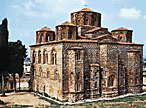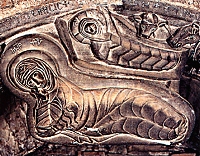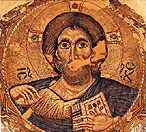 |
|
 |
The Virgin Paregoretissa
 he church of the Virgin Paregoritissa, which had formerly been the
katholikon
of a monastery, was founded by the despotes of Epiros
he church of the Virgin Paregoritissa, which had formerly been the
katholikon
of a monastery, was founded by the despotes of Epiros
 Nikephoros I Komnenos-Doukas
and his wife
Anna Palaiologina.
A carved dedicatory inscription on the arched lintel of the
imperial door
records the names of the ruling couple, that is of the despot Nikephoros and his wife Anna, and that of their son, the "komnenoblastos" (blastos = sprout), the despotes Thomas. This high patronage explains the
superior quality of the architecture, as well as of the sculptures and the mosaics that adorn the church. The monument belongs to a peculiar type of
domed octagon
Nikephoros I Komnenos-Doukas
and his wife
Anna Palaiologina.
A carved dedicatory inscription on the arched lintel of the
imperial door
records the names of the ruling couple, that is of the despot Nikephoros and his wife Anna, and that of their son, the "komnenoblastos" (blastos = sprout), the despotes Thomas. This high patronage explains the
superior quality of the architecture, as well as of the sculptures and the mosaics that adorn the church. The monument belongs to a peculiar type of
domed octagon
 with a two-storey peristyle, and is topped by five domes. On the outside, the impression it conveys is that of a voluminous cubic building pierced with windows reminiscent of palatial constructions. Its singularity lies in the manner in which the central space is covered: whereas the ground plan of the church is that of a domed octagon with a vaulting system, at a higher level the space covered by the dome diminishes, so that finally only four arches are needed to support the dome. Recent research has put forward the view that the architectural form of the church as we see it today is not the original one, and that, in its first phase, the monument was a
cross-in-square church.
Foreign influences, mainly from the opposite side of the Adriatic, are evident in the sculptures decorating the church, which are strongly reminiscent of later
with a two-storey peristyle, and is topped by five domes. On the outside, the impression it conveys is that of a voluminous cubic building pierced with windows reminiscent of palatial constructions. Its singularity lies in the manner in which the central space is covered: whereas the ground plan of the church is that of a domed octagon with a vaulting system, at a higher level the space covered by the dome diminishes, so that finally only four arches are needed to support the dome. Recent research has put forward the view that the architectural form of the church as we see it today is not the original one, and that, in its first phase, the monument was a
cross-in-square church.
Foreign influences, mainly from the opposite side of the Adriatic, are evident in the sculptures decorating the church, which are strongly reminiscent of later
 Romanesque art.
Romanesque art.
The mosaic decoration, quite badly damaged, is preserved only in the central dome of the church. The centre of the dome
 is occupied by a bust of Christ Pantokrator. Exactly underneath, around the drum of the cupola, between the windows, are portrayed the full-length figures of twelve prophets and among them celestial powers (seraphim and cherubim). In the open scrolls held by the prophets are inscribed passages from the Old Testament relating to their prophecies. The delicate proportions of the forms, the boldness of the chromatic combinations, the liveliness and expressiveness of the countenances and the skilful manner in which the figures have been incorporated into the architectural space, are the basic features that characterise the mosaics. These features herald the stylistic developments of the second phase of Palaiologan art. The connection of Anna Palaiologina to the Capital leades us to assume that the craftsmen who created these works had come from Constantinople. According to the inscription, the mosaics and the church are dated between 1294 and 1296. is occupied by a bust of Christ Pantokrator. Exactly underneath, around the drum of the cupola, between the windows, are portrayed the full-length figures of twelve prophets and among them celestial powers (seraphim and cherubim). In the open scrolls held by the prophets are inscribed passages from the Old Testament relating to their prophecies. The delicate proportions of the forms, the boldness of the chromatic combinations, the liveliness and expressiveness of the countenances and the skilful manner in which the figures have been incorporated into the architectural space, are the basic features that characterise the mosaics. These features herald the stylistic developments of the second phase of Palaiologan art. The connection of Anna Palaiologina to the Capital leades us to assume that the craftsmen who created these works had come from Constantinople. According to the inscription, the mosaics and the church are dated between 1294 and 1296.
|